Tips for producing an amazing high school art sketchbook
Final Updated on January 10, 2022
This commodity contains tips, examples and guidance to aid students produce an outstanding sketchbook as office of a loftier school art course. It is intended to assistance students studying a broad range of high school art qualifications, including IGCSE / GCSE Art, A Level Fine art, IB Visual Art (the Procedure Portfolio or Investigation Workbook / IWB), and NCEA Level iii Scholarship. It outlines all-time practice in terms of content and page layout, providing ideas and recommendations for students of whatever discipline (including Painting / Fine Fine art, Graphic Design, 3D Design, Architecture, Printmaking, Photography, Textiles, or Fashion students).
Desire more guidance? Some of this material and much more is in our new volume: Outstanding High School Sketchbooks . This book has high-resolution images so that fine details and annotation are clear, making it an first-class resource for students and schools. Learn more!
Contents
- What is a loftier schoolhouse sketchbook?
- What should a sketchbook incorporate? (A sketchbook checklist)
- Sketchbook presentation tips
- Sketchbook formats – options bachelor
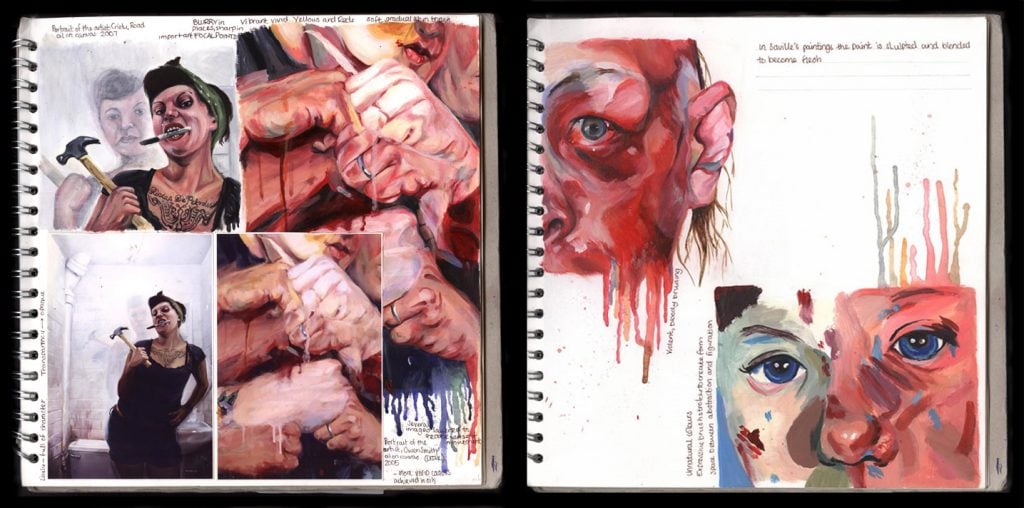
What is a sketchbook?
A sketchbook is a creative document that contains both written and visual material. It may include teacher-guided sketchbook assignments or self-directed investigations. A sketchbook helps you to call back through the stages of the creative process: researching, brainstorming, experimenting, testing, analyzing, and refining compositions. It is a place to certificate your journeying towards a final solution, providing depth and backstory to the accompanying artwork. A sketchbook is an of import part of many visual art courses.
What should a sketchbook contain? (A sketchbook checklist)
Many loftier school art projects have flexible, open-ended requirements. The recommendations below explicate what is typically expected in a loftier-quality sketchbook.
Start-hand engagement with the subject matter
Information technology is essential to demonstrate a clear personal connexion to the theme/southward explored in your sketchbook. You can do this by drawing from kickoff-hand ascertainment; working from original photographs; documenting personal visits to galleries, historic places, museums, or blueprint sites; and explaining the personal context surrounding your work (how the work is relevant to y'all and your life).
A project based solely on secondary sources (such as images from the net, books, or magazines) is typically frowned upon past examiners and may lead to superficial work, a lack of engagement, and plagiarism. (Relying upon 2d-mitt imagery is one of the Top ten Mistakes made past fine art students.)
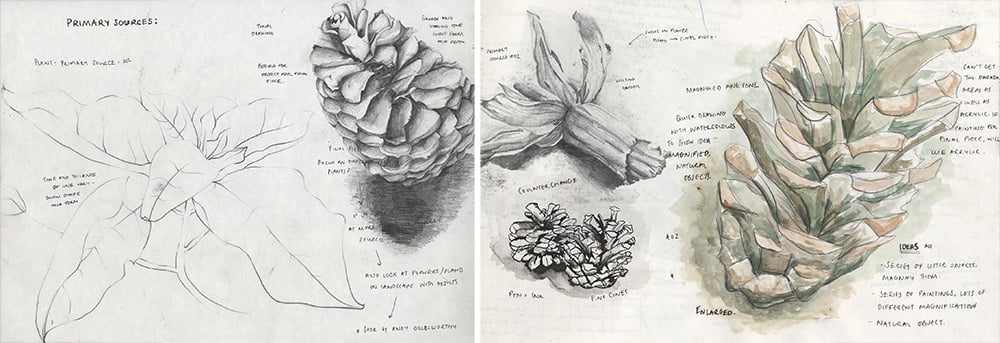
Exploration of limerick, visual elements, and design principles
An important part of the sketchbook is to aid the planning and refining of larger artworks. This might include composition studies, thumbnail sketches, or layout drawings (exploring format, calibration, enlargement, cropping, proportion, viewpoint, perspective, texture, surface, color, line, shape, grade, space, and so on); design ideas; photographs of conceptual models or mock-ups; storyboards; photographic contact sheets; analysis of accompanying portfolio work; and many other forms of visual thinking.

Original drawings, paintings, prints, photographs, or designs
Fill your sketchbook with original visual material—particularly work that is exploratory, incomplete, and experimental (equally opposed to finished artwork). Visual material should support the theme of the project, rather than describe a random collection of unrelated subject matter.

A wide range of media and materials
Your sketchbook should contain a wide range of media and materials, as appropriate for the project and expanse of specialty. Include photographs of any three-dimensional exploration. A broad list of possible media and materials is listed below:
Drawing and painting surfaces: colored and textured papers of varying weights, such as tissue paper, watercolor newspaper, newsprint, or cartridge; cardboard; transparent sheets, plastic overlays, or tracing paper; discarded wallpaper, patterned newspaper, or printed sheets; photographic paper or other specialized press papers; painted or prepared grounds; masking record or other adhesive surfaces; collaged materials; dried textures created with acrylic pastes or compounds; canvas, hessian, or other fabrics; other appropriated items. (See more examples of drawing and painting surfaces in our four-part Creative Use of Media series for loftier school art students.)
Cartoon and painting media: graphite pencil; colored pencil; ballpoint pen; ink pen; calligraphy pen; marker pen; chalk; charcoal; crayon; pastel; drawing ink; printing ink; natural or manmade dye, such as from commercial pigments, walnut skins, coffee stains, or food dye; gouache; watercolor; acrylic pigment; oil paint; spray paint; business firm paint; shellac/varnish; fixative; wax; painting mediums, such as thinners, gel/gloss, glazes, drying retarders, textural pastes, or modelling compounds.
Threads and textiles: natural fibers, such as cotton, silk, flax, or raffia; wool and other creature hair, furs, or leather; synthetic threads, such every bit nylon, acrylic, or polyester; textiles of different weights, weaves, patterns, prints, or colors; upcycled textile, including from non-traditional sources such as repurposed woven plastic bags; elastic; sewing threads; embroidery threads; string; rope; beads.
Sculptural materials: glues or adhesives; papier-mâché; table salt dough; modelling clays or ceramics; feathers, bone, or other animal materials; food; seeds, leaves, cane, balsa, or other woods; sand, earth, pumice, rocks, or rock; wax; plaster; latex; Styrofoam; plastics; resin; concrete; fiberglass; wire, foil, or other metals; ice; light; other organic and manmade plant materials.
Tools and technology: brushes; airbrushes; sponges; paint rollers; palette knives; arts and crafts knives; scissors; stencils; engravers; sandpaper; chisels, pliers, or other woodworking tools; metalworking tools; newspaper trimmers; pottery wheels; crochet hooks, needles, sewing machines, or overlockers; looms; traditional or digital cameras; darkroom equipment; kilns; printing presses; photocopiers; scanners; computer-aided design (CAD) software such as Adobe Photoshop, Adobe InDesign, or SketchUp Pro; computer-aided manufacture (CAM) equipment such as 3D printers and light amplification by stimulated emission of radiation cutters.

A wide range of art-making techniques, processes, and practices
The techniques, processes, and practices explored in your sketchbook should be appropriate for the project and area of specialty. Try to apply both traditional and contemporary approaches. These should exist informed by the study of relevant artists and kickoff-hand practical experimentation. Complex processes tin can be documented using diagrams, annotated screenshots, or photographs of piece of work in progress (this can help to evidence that the finished pieces are your ain work). Don't certificate every technique at every stage of production. This is a space-filling device that pushes out more relevant content.

Artist research
The sketchbook is an excellent identify to document learning from the work of artists. This might include whole or partial copies of relevant artwork accompanied by critical analysis and practical experimentation where appropriate. Artists should be selected purposefully and offer valuable learning opportunities in their approach to subject-matter, composition, technique, or apply of media. Aim to study the piece of work of both historical and contemporary artists from a range of different cultures. Avert bulking up the sketchbook with gallery pamphlets, fliers, brochures, or other printed textile from secondary sources.
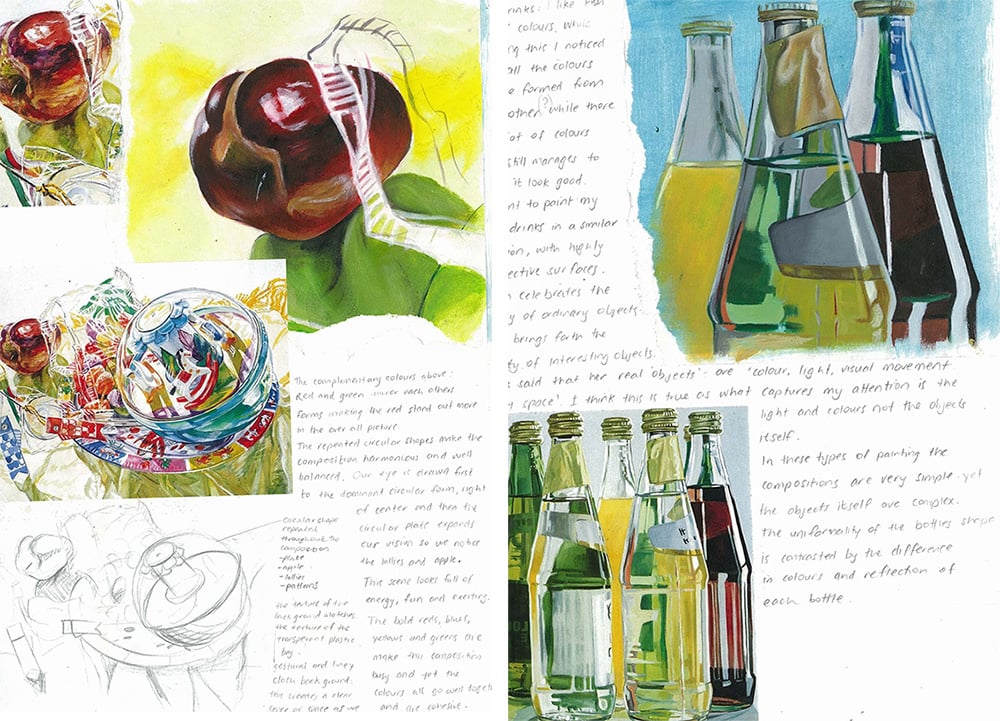
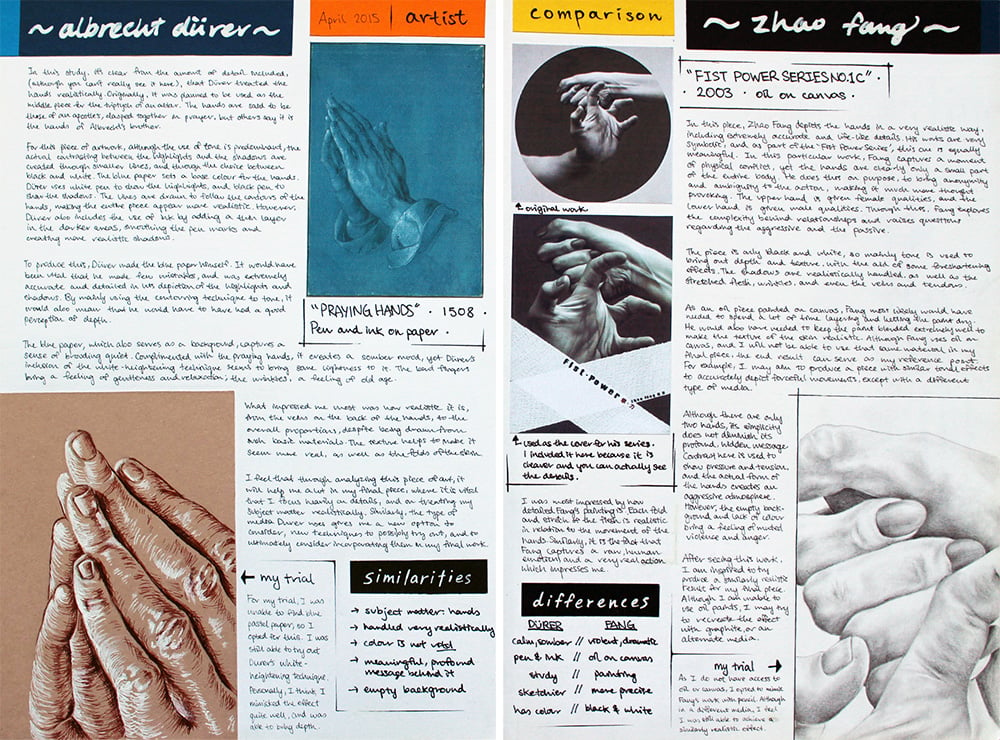
Sketchbook presentation tips
A loftier school sketchbook should be reminiscent of the kind of document that an artist or designer might create. It does not need to be overworked, perfect, or polished. The post-obit tips provide wide guidance in terms of page layout and presentation style.
Keep it simple
Avoid intrusive lettering, elaborate front end covers, decorative borders, over-the-top backgrounds, or unnecessary framing or mounting. Fold-out tabs add an interactive element but risk examiners missing work, so are all-time avoided.
Use pocket-size, legible handwriting—this way, any spelling or grammatical errors are less distracting. Write with graphite pencil or black, greyness, or white pen.
Exercise non spend weeks dreaming up inventive layouts or researching presentation ideas on the net. Focus on what matters: producing quality fine art and design work.
Your sketchbook can be a straightforward, ordered presentation of your work, research and insights: Let your images do the impressing. Overly designed pages can often have too long and be a lark to the viewer.
Chris Francis, Senior Leader, Instructor of Art and Photography, St Peter's Cosmic School, Bournemouth, England

Use a consistent presentation style
Some students favor hard-edged, 'cleaner' presentation methods; others adopt a messier, gestural mode. Neither is better than the other: both tin can be executed well. Jumping from ane presentation style to another, yet, may consequence in a submission that is distracting and disjointed.
Vary page layouts to create visual interest
Some sketchbook pages should have many illustrations, others a single artwork, and the residue something in between. Vary the positioning of images and text on the page. Don't be afraid of white space.
Order work so that information technology shows the development of ideas
Although a sketchbook is an breezy, free-flowing document, it is important to retrieve that an examiner picks it up and 'reads' it in a brusk period of time. Structure the sketchbook in a way that reflects the overall development of your projection.
Do not bulk up your sketchbook with weaker work
Weak work sets off alarm bells for an examiner, alerting them to be on the picket for weaknesses elsewhere. This does not mean that anything 'less than perfect' should be discarded. Mistakes provide valuable learning opportunities and cues for how subsequent learning took place. Withal, you must discriminate. If an paradigm is glaringly worse than others, consider improving or eliminating it. Seek your teacher's guidance before removing any artwork; improving existing work is oft much faster than starting anew.
Craft the sketchbook with care
The sketchbook offers an opportunity to remind the examiner that you lot are a dedicated, hard-working educatee, and that you care nigh the field of study. This does non mean you must cram your sketchbook with intense, labored work (sometimes an expressive two-infinitesimal charcoal cartoon is all that is needed), just rather that the sketchbook should speak of your attempt, commitment, and passion.
You may also exist interested in reading How to annotate a sketchbook, which contains illustrated examples from high-achieving students effectually the world.
Sketchbook formats – options available
For convenience, well-nigh students select a sketchbook that is A4 (viii.5 x 11 in) or A3 (11 x 17 in) in size. An A4 sketchbook fits in a schoolbag and is thus less likely to be lost or damaged during transit. An A3 sketchbook fits more than work per page and provides space for larger artworks. If the sketchbook contains all preparatory cloth without any additional sheets of developmental work required, an A2 (17 10 22 in) sketchbook may exist advisable. Not-conventional sizes or electronic submissions may too be possible. Remember that format requirements are frequently gear up past an examination board, instructor, or school.
Regardless of the sketchbook size, it is best to work consistently in portrait or landscape orientation, rather than alternate from page to page. Consequent page orientation makes it easier for an examiner to flip through the sketchbook and view your piece of work. Landscape orientation is preferable for electronic submissions, every bit this displays well on digital screens.
Four possible sketchbook formats are summarized on the following pages. These are just a few of the options available.
Pre-bound sketchbooks
Pre-bound sketchbooks should contain quality creative person paper suitable for both moisture and dry media. A minimal appearance is all-time: choose a sketchbook with a plainly encompass, without distracting logos or ornament. A spiral-bound book allows you to remove pages easily.
The chief disadvantage of a pre-bound sketchbook is that it is hard to work with moisture media on several pages at once. (Moving quickly between pages saves time, aids the development of ideas, and facilitates connections between pieces.) Nonetheless, pre-leap sketchbooks are the most pop format due to their convenience and wide availability.
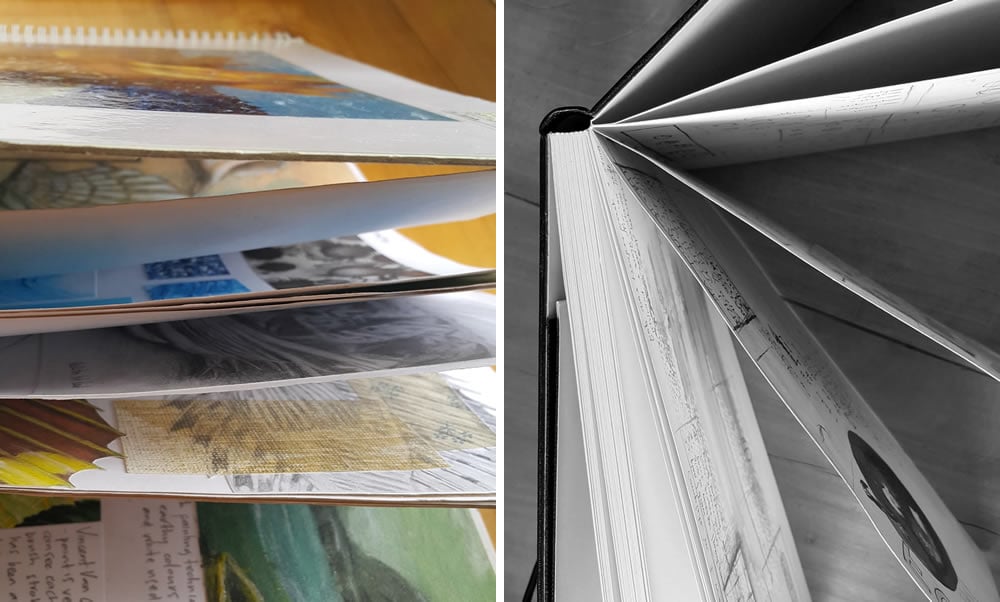
Refillable display books
Another pop presentation method is to shop loose sheets of paper in a refillable brandish book. The plastic sleeves protect the work and reduce smudging from one page to another. This method is less daunting than using a pre-jump sketchbook, as there is no fear that each folio must exist 'perfect'—pages can be removed, added, and re-ordered with ease. Creating a sketchbook from private sheets also allows easy integration of unlike newspaper types, encouraging the utilise of a broad range of media. In improver, you can piece of work on multiple pages at once without waiting for piece of work to dry.
A disadvantage of this method is that loose sheets are more probable to go lost or damaged. The plastic sleeves besides hinder the viewing of surface quality and texture, particularly if the sleeves get crumpled or muddied. For this reason, you may wish to change to a clean, non-cogitating display book immediately before assessment.

Self-bound booklets
Many schools ain a manual binding machine. This punches a series of holes along one side of a certificate so that a screw bounden can be inserted to concur the pages together. A clear plastic cover tin can be added to protect the piece of work. Binding usually takes place once the submission is complete, with sketchbook pages stored equally individual sheets of paper beforehand. Other binding methods are also possible if these permit the sketchbook to lie flat when open.
Every bit with refillable display books, different newspaper types can exist used, and working on more one page at in one case is possible. Pages can likewise be removed, added, and re-ordered with ease.
This method is more time-consuming than others and is prone to user error (such as holes punched along the wrong side of an artwork). Nonetheless, information technology is an cheap way to create a high-quality, personalized sketchbook.

Digital sketchbooks
A digital sketchbook typically takes the course of an online portfolio created using a website design platform such equally WordPress. A digital sketchbook relies on access to high-speed internet and an appropriate laptop, calculator, or other device. Images, videos, and typed annotations are presented on website pages using hyperlinks, menus, and categories to organize content.
The main advantage of an online portfolio is that yous can include digital images, audio, and video footage with ease. Digital sketchbooks are growing in popularity, particularly for students who specialize in film, photography, and digital media.
If you opt for a digital sketchbook, brand sure you have backup copies of files stored on a memory stick or deject server (an automatic backup service, such as Dropbox, is recommended) with digital files stored in labeled folders on your device. It is also wise to print a copy of each online portfolio folio. These printouts tin can be bound and submitted so that examiners have a physical re-create in example of technological difficulties.
Before opting for a digital sketchbook, it is worth remembering that long hours online and the distraction of social media tin affect mood and sleep, compromising your productivity and quality of work overall.
There are also benefits to keeping a traditional sketchbook aslope a digital portfolio. This helps verify the authenticity of your digital work, allows the spontaneous transfer of ideas by manus, and strengthens and consolidates your practical art-making techniques.
For more than information on creating a digital sketchbook, please read: How to create an ePortfolio: a guide for students.
Examples of great art sketchbooks: a visual tour
Nosotros have created a serial of articles showcasing outstanding fine art sketchbook examples. These comprise some of the best A Level Art sketchbook pages from students (many of which received full marks), also as excellent artist sketchbooks, showcasing different approaches, techniques and presentation methods. It is hoped that they provide a motivational resource for students from a broad range of qualifications. These are organized into the following categories:
- Painting / fine art sketchbooks
- Photography sketchbooks
- Graphic pattern sketchbooks
- Textile and fashion design sketchbooks
- Sculpture, architecture, and 3D Pattern sketchbooks
- Digital sketchbooks

Amiria has been an Fine art & Design teacher and a Curriculum Co-ordinator for seven years, responsible for the course design and assessment of student work in 2 loftier-achieving Auckland schools. She has a Bachelor of Architectural Studies, Bachelor of Architecture (First Grade Honours) and a Graduate Diploma of Teaching. Amiria is a CIE Accredited Art & Design Coursework Assessor.
Source: https://www.studentartguide.com/articles/a-level-art-sketchbook
0 Response to "Tips for producing an amazing high school art sketchbook"
Post a Comment